Cardiac Ultrasound - PowerPoint PPT Presentation
1 / 24
Title:
Cardiac Ultrasound
Description:
Electronic steering is done with pulse delays in 1D Array. Gives pie-slice' image shape . Electronic steering. Mechanical steering. Steering and Focusing. ... – PowerPoint PPT presentation
Number of Views:2291
Avg rating:3.0/5.0
Title: Cardiac Ultrasound
1
Cardiac Ultrasound
- Greg Gallardo
- 51286
- Contemporary Topics in Bioimaging
2
Introduction
- Ultrasonic imaging is one of the most frequently
used imaging modalities today - Started in the 1940s. Not well accepted until
the 1970s - Ultrasonic waves are non-ionizing radiation, and
considered safe - Hardware is portable and relatively inexpensive.
- It can produce images in real time.
- Good resolution
3
Topics of Discussion
- Traditional 2D Imaging Techniques
- 3D and 4D Imaging Techniques
- Current Issues
4
Background
- Ultrasonic waves are acoustic waves with
frequencies higher than 20kHz - Require a medium for propagation
5
Background
- Wave pressure decreases as it propagates through
the body - Some energy is reflected at boundaries
6
Transducers
- Piezoelectric Crystal
- Expand and contract when voltage is applied
- Create voltage when compressed or stretched
7
2D Cardiac Imaging
- The transducer transmits high-frequency (1 to 5
megahertz) sound pulses into the subject. - The pulses travel into the subject and encounter
boundaries between different tissue types. These
boundaries reflect part of the sound waves back
to the probe. The remaining wave energy
propagates further into the body and can get
reflected at other boundaries. - The probe detects reflected waves. The time
taken for the echo to return to the probe is used
to calculate the distance of the tissue boundary. - The machine displays the distances and
intensities.
8
Beam focusing
- Beam forming is the steering and focusing of the
ultrasound beam. - Can be focused with a lens
- Electronic focusing is also done with pulse
delays in a linear phased array
9
Beam Steering
- Steering can be mechanical or electronic
- Electronic steering is done with pulse delays in
1D Array - Gives pie-slice image shape
10
2D Image plane
- 1D array only allows control in 2 directions
(lateral and range) - No steering in elevation dir
11
2D Cardiac Imaging
- Limited access to heart. Rib cage and lung
surround heart (limited access) - Standardize on certain slice types.
12
3D Cardiac Imaging
- Several different methods
- Rotational Probes
- Freehand Probes
- Real-Time Three Dimension Ultrasound
- Rotational and Freehand probes use traditional 1D
phased arrays
13
Rotational Probe
- 2 steps
- Acquisition of multiple 2D images with 1D phased
array - Reconstruction Interpolation
14
Freehand probes
- Similar to rotational probes
- Acquire series of 2D images
- Reconstruct 3D from 2D images
- Adds sensor to track probe motion
15
Real Time 3D
- Developed at Duke University
- (Smith, von Ramm)
- Uses 2D phased array instead of 1D array
- Steer beam with delays
16
RT3D delay calculation
Select range F, azimuth steering angle ?j and
elevation steering angle ? for a focal point on
scanline j
17
RT3D delay calculation
- Propagation time
- Pulse Delay
- Where toj gt tij for all i
18
Benefits
- Eliminates variability due to transducer
positioning - FastCapture 20-30 volumes a second
- Allows new views
- Plane perpendicular to transducer
- In elevation plane
19
Example (SONOS 7500)
20
Example (SONOS 7500)
21
Areas of research
- Duke university Improve 2D phased array systems
- 2D arrays have lower resolutions than 1D arrays
- 2D arrays have smaller Field of View
- Original system had 32 Tx and 32 Rx channels with
81 parallel processing - Nov 2003 current T5 system has 512 Tx and 512 Rx
channels with 321 parallel processing. - Goal is gt1000 Rx channels with 641
22
Areas of research
- Duke RT3D Intravascular Ultrasound
- Traditional IVUS
- 1 - Rotating shaft
- 2 - Acoustic window
- 3 - Ultrasound crystal
- 4 - Rotating beveled acoustic mirror
- Duke 2D arrays face forward
- Allow real time B-mode and C-mode scans of
vessels and vascular stents. - Easier to obtain flow information
23
Areas of Research
- Doppler echo-cardiography.
- Problem cannot get velocities perpendicular to
transducer - Many proposed methods of calculating Some use
multiple views. - 2D array allows more views and angles than
traditional 1D array
q
24
Phillips 3D Color Doppler
- Introduced last year
- First commercial 2D phased array with real time
color Doppler imaging

